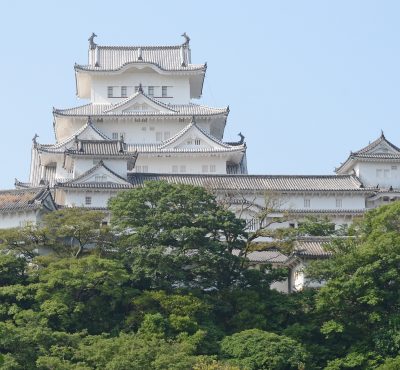What makes Nagoya
the “Heartland of the Samurai?”
Nagoya is where the three founders of modern Japan were born.
Oda Nobunaga, Toyotomi Hideyoshi and Tokugawa Ieyasu. It is no coincidence that these three heroes of Japanese history were born in Nagoya. Here, through the forests and mountains of Aichi prefecture, flows the Mikawa River (Kiso Mikawa), where many of Japan’s leading potteries and textile mills are located. The first shogun to appear in this prosperous land was Oda Nobunaga. He is the leader who broke with the ways of the past, and ushered in a new age for Japan. His legacy was furthered by his successor, Toyotomi Hideyoshi, who was in turn followed by the last great and absolute ruler of Japan, Tokugawa Ieyasu, who established a centuries-long period of stability and peace. In this way Japan evolved from a feudal landscape into a modern nation. Not only politics and the economy, but culture, arts, cuisine and much else was forever transformed under the three shoguns. For instance, it was during this period that the tea ceremony, the sport of sumo, the board games of shogi and go, various storytelling forms such as rakugo, and the theater of kabuki, were established. In fact, the origins of all of the “traditional” Japanese arts of today can be traced back to the time of the great samurai leaders.
Oda Nobunaga

Toyotomi Hideyoshi

Tokugawa Ieyasu

In the Edo period, seventy percent of Japan’s samurai lords hailed from Nagoya!
Oda Nobunaga, Toyotomi Hideyoshi and Tokugawa Ieyasu. During the nearly 300 years of the “age of the three heroes” the entire country was controlled by samurai of their clans, meaning that seventy percent of the Edo lords originated from Aichi (Nagoya.) Under their influence, the culture of Nagoya – language, customs, lifestyles, cuisine – became the culture of the entire land, with many terms of samurai speech becoming standard usage in the Japanese language.

The influence of Nagoya is found throughout Japan.
Nagoya’s legacy is to be found everywhere in Japan.
Here are just a few examples:
- Tokugawa Ieyasu designed Japan’s capital, Tokyo. Edo, as it was then called, was home to many samurai from Mikawa (Aichi), to the extent that their history in Edo is referred to as the Mikawa culture. The Edo dialect was derived from the Mikawa dialect. The roots of the Mikawa Festival, which is held on the New Year’s holiday at Edo Castle, are likewise in Aichi. Even the traditional sake brewers of Edo were merchants from Mikawa, hence the term “Mikawaya” for the numerous sake houses of Edo.
- The cities of both Kyoto and Osaka were planned by Oda Nobunaga, and constructed under the administrations of Toyotomi Hideyoshi and Tokugawa Ieyasu.The Awa dance, found throughout the lands of Tokushima prefecture, was brought there by Aichi-born samurai lord Hachisuka Koroku. The Bull Ogre Festival of Ehime prefecture and the Gujo Dance of Gifu prefecture are likewise cultural products of Nagoya.
- Many of the place names of Tokyo, and elsewhere in Japan, were brought from Aichi. For instance, in Tokyo these include Shinjuku, Hanzomon, Yurakucho, Kanda-Mikawamachi, Aoyama, Sukiyabashi, Kamiyacho, and Hachobori, among many others.
- Many of the castles of Japan, all of which are designated as national treasures, were built by the samurai of Aichi. These include Inuyama Castle (of Oda Nobunaga), Himeji Castle (of Ikeda Terumasa), Hikone Castle (of Ii Naomasa) and Matsumoto Castle (of Ishikawa Kazumasa.)
Awa Odori Festival
Himeji Castle

